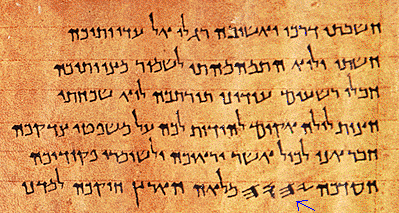|
|
|
|

The divine name is
pronounced:
ee ah oo eh or ee ah oo
ay. "ee" as in "feet,"
and "ay"5 as in
"bay". It is usually spelled consonantly
either YHWH or YHVH. The "Y" is pronounced as in
"Lily" or "yes". The waw (W)
or vav (V) acts as a vowel here, and in fact is a shureq written fully, if we are to express it as YHVH (![]() )2, or a waw,
pronounced "oo" as in "boot" if we are to write
it as YHWH (
)2, or a waw,
pronounced "oo" as in "boot" if we are to write
it as YHWH (![]() )1. You will notice that all of
the consonants are vocalized as vowels, since according to Josephus
the divine name was four "vowels."3. Josephus was both a priest and a
Pharisee. The fact that the divine name
was four vowels shows that the pronunciation "Yahveh" is
incorrect, and for those who must argue that "vav" was not
anciently "waw," I will say that "vav" only need
be rendered as the shureq to turn it into
the necessary vowel. The spellling YHVH comes from
the German JHWH or JHVH, in which language "J" was
pronounced "Y", and "W" as "V"!
The "V" sound is in turn derived from the old Latin,
in which language "V" and "U" were the same
letter, which no doubt is the source of the Ashkenazi
confusion. That the "waw" or "vav" is a
vowel in the divine name is further proven by the fact that the
names of many of the prophets, like Ayliyahu end in a shureq waw. By the way, the accent in
the divine name is on the last syllable. That is why there is
a short vowel on the first syllable.
)1. You will notice that all of
the consonants are vocalized as vowels, since according to Josephus
the divine name was four "vowels."3. Josephus was both a priest and a
Pharisee. The fact that the divine name
was four vowels shows that the pronunciation "Yahveh" is
incorrect, and for those who must argue that "vav" was not
anciently "waw," I will say that "vav" only need
be rendered as the shureq to turn it into
the necessary vowel. The spellling YHVH comes from
the German JHWH or JHVH, in which language "J" was
pronounced "Y", and "W" as "V"!
The "V" sound is in turn derived from the old Latin,
in which language "V" and "U" were the same
letter, which no doubt is the source of the Ashkenazi
confusion. That the "waw" or "vav" is a
vowel in the divine name is further proven by the fact that the
names of many of the prophets, like Ayliyahu end in a shureq waw. By the way, the accent in
the divine name is on the last syllable. That is why there is
a short vowel on the first syllable.
Clement of Alexandria spelled the
divine name
Iaoue
and Iaouai6 which is prounounced in Greek ee ah oo
eh, just as in Hebrew, and ee ah oo ay.
Probably the variation "Y ah oo ay" is more correct than
"Y ah oo eh." The spelling
Iabe found in some
places is due to the fact that in ancient Greek b carried the value of the
Latin "v" (Spanish uses "b" for "v"
also). Strictly speaking, this translation is an erorr, but
since Latin "v" and "u" were the same, we
can see why it happened.


All Rights Reserved.
Send us email.
www.parsimony.org